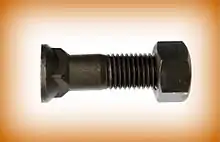Carriage bolt
A carriage bolt (also called coach bolt and round-head square-neck bolt[1] is a form of bolt used to fasten metal to metal or metal to wood.

It is distinguished from other bolts by its shallow mushroom head and the fact that the cross-section of the shank, though circular for most of its length (as in other kinds of bolt), is square immediately beneath the head.[2] This makes the bolt self-locking when it is placed through a square hole in a metal strap. This allows the fastener to be installed with only one tool, a spanner or wrench, working from one side. The head of a carriage bolt usually is a shallow dome. The shank has no threads; and its diameter equals the side of the square cross-section.
The carriage bolt was devised for use through an iron strengthening plate on either side of a wooden beam, the squared part of the bolt fitting into a square hole in the ironwork. It is common to use a carriage bolt to bare timber, the square section giving enough grip to prevent rotation.
The carriage bolt is used extensively in security fixings, such as locks and hinges, where the bolt must be removable from one side only. The smooth, domed head and square nut below prevent the carriage bolt from being unlocked from the insecure side.
Timber bolt
Closely related to the carriage bolt is the timber bolt (also called mushroom-head bolt and dome-head bolt), meant to fasten wood to wood (rather than metal to wood), for use with large wood planks and structures. It has a domed head that is proportionally wider than that of a carriage bolt. Instead of the carriage bolt's square part of the shank immediately under the head, the timber bolt has four fillets, whose sharp corners grip the edge of the hole in the wood to prevent rotation.
Plough bolt

The plough bolt is a flush-fitting carriage bolt, whose head is countersunk beneath the surface of the wood. The plough bolt was devised to hold replaceable ploughshares to the mouldboards of iron ploughs. The share, the fastest-wearing part of the plough, would be replaced several times over the life of the plough. Such bolts continue to be used to hold shovels onto cultivators.
See also
- Coach screw or lag bolt, a square- or hex-headed screw with a tapered woodscrew thread.
References
| Wikimedia Commons has media related to Carriage bolts. |
- Machinery's Handbook (Twenty-First ed.). New York: Industrial Press. 1980. p. 1146.
- Machinery's Handbook (Sixth ed.). New York: Industrial Press. 1927. p. 827.
